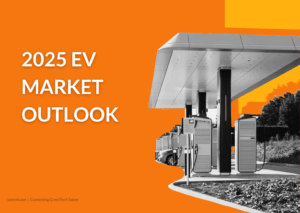
Electric Revolution Accelerates
Over the past decade, the eMobility sector has seen massive leaps in technology and adoption, accelerating forward faster than we have ever seen before. Electric Vehicles have been at the center of this transition from traditional mobility to emobility, redefining how we think about mobility in general.
In recent years there has been tremendous growth for the electric vehicles market, as changing regulations, jumps in tech capabilities, volatility in gas prices and increased competition has created a perfect storm for growth in the sector.
Now in 2025, you’ll be hard pressed to find a major auto manufacturer that doesn’t offer EVs alongside their ICE offering – With some brands like Jaguar already moving to an all electric offering, with other brands like Audi, Rolls Royce and Volvo committing to move away from ICE engines entirely within the next decade.
The auto industry’s push away from ICE is also being reflected consumer side, asIncentive programs, increased charging infrastructure and instability in the cost of gas has also made EVs a very attractive proposition for consumers,with 38% of Americans seriously considering an EV when it comes to buying their next car.
On the surface it looks like the EV market has a clear path ahead for a future where all forms of transit are powered by electricity, but there are still barriers to the widespread adoption of electric vehicles, such as issues with cybersecurity, semiconductor chip shortages, batteries, and changing regulatory focuses.
As we near the end of 2025, Storm4’s EV recruitment team have taken an overview of the EV market to identify the key trends and focus points that will impact the market going into 2026.
1. Batteries: Powering Growth Amid a Precarious Supply Chain
Battery technology remains at the heart of the EV revolution. Advances in solid-state batteries, fast-charging capabilities, and energy density are enabling longer ranges and shorter charging times, bringing EVs ever closer to parity with traditional vehicles in terms of range and in some cases surpassing ICE engines in terms of raw power output.
However, behind the scenes, a fragile supply chain continues to cast a shadow over progress. The availability of critical rare earth metals, including lithium, nickel, cobalt, and manganese, remains uncertain, as geopolitical instability and limited mining capacity create bottlenecks.
Manufacturers are increasingly looking to localize battery production and secure raw materials through long-term partnerships, but the demand for these rare earth metals is still outpacing supply availability. This imbalance could limit how fast automakers can scale, especially as consumer demand for longer-range, higher-performance EVs continues to grow.
In 2025, expect to see a strong push toward battery recycling, second-life applications, and closed-loop supply chains as firms work to mitigate these risks and secure sustainability credentials.
2. Cybersecurity: Protecting the Connected Car
As vehicles become more connected and autonomous, cybersecurity has emerged as one of the most urgent priorities in the automotive industry. The average EV now contains millions of lines of code and is increasingly reliant on cloud-based systems for diagnostics, navigation, and over-the-air updates.
This creates potential entry points for cyberattacks, whether through infotainment systems, mobile apps, or vehicle-to-grid communications. In response, automakers are investing heavily in cyber defense capabilities, hiring specialized cybersecurity engineers, and partnering with tech firms to strengthen both internal networks and on-vehicle systems.
The U.S. National Highway Traffic Safety Administration (NHTSA) and global regulators are also drafting stricter vehicle cybersecurity standards, placing additional pressure on manufacturers to stay compliant and proactive. In 2025, cybersecurity will no longer be an afterthought, it will be a core component of EV design and development.
3. Regulatory Pressures: A Changing Political Landscape
Policy continues to be one of the biggest drivers and risks for the EV market – Domestically in the United States, government attitudes toward electric vehicles have shifted considerably over the past few years.
While previous administrations introduced EV-friendly incentives such as tax credits under the Inflation Reduction Act, the current political climate has become more skeptical, with calls to reassess subsidies and focus instead on “energy independence.”
This regulatory volatility creates uncertainty for automakers planning multi-billion-dollar EV investments. In contrast, the European Union and China continue to strengthen their EV commitments, enforcing stricter emissions standards and offering significant industry incentives, creating an environment where manufacturers are more comfortable investing into research & development for EV tech..
During the closing months of 2025 moving into 2026, global automakers will need to navigate an increasingly complex web of policies, balancing short-term political volatility in the U.S. with long-term opportunities abroad.
4. International Competition: The Global EV Arms Race
The global EV landscape has become more competitive than ever. While the U.S. started the EV race with a sizable lead thanks to Tesla pioneering large-scale EV adoption, international players are quickly closing the gap.
European automakers are leveraging their expertise in luxury and mid-range design to dominate the premium EV segment, while Chinese manufacturers such as BYD and NIO are flooding global markets with low-cost EVs that appeal to first-time buyers.
This dual-front challenge puts pressure on U.S. brands to maintain innovation while keeping costs competitive. To stay ahead, American EV firms are investing in advanced manufacturing, AI-driven production optimization, and strategic partnerships with domestic suppliers.
Going into 2026, expect the EV market to become even more dynamic than it has been in previous years, as more players enter the battle for top EV talent and market share.
5. Semiconductor Shortages: A Persistent Pain Point
Despite improved supply chain resilience, the supply of semiconductors continues to be a bottleneck in EV production, impacting production timelines and costs. EVs require significantly more chips than traditional vehicles and even minor disruptions in the global semiconductor market can have dramatic impacts on the market.
Tensions between the U.S. and China over microchip technology and export controls could exacerbate supply risks. In response, U.S. companies are looking to onshore semiconductor manufacturing under initiatives like the CHIPS and Science Act, and recruiting specialized talent to strengthen domestic production.
While these moves are promising, building self-sufficient semiconductor ecosystems will take time. Until then, semiconductor vulnerabilities will remain one of the most critical risk factors for the EV industry.
6. Charging Infrastructure: The Next Frontier of Accessibility
Charging availability remains one of the most visible barriers to widespread EV adoption, especially in more rural communities. Although the network of public chargers in the U.S. has expanded dramatically since 2020, growth in EV ownership is looking to outpace infrastructure deployment if current trends continue.
Consumers still cite range anxiety and inconsistent charger reliability as key concerns when considering purchasing an EV. So for mass adoption of EVs to continue, governments and private companies must coordinate to ensure equitable access to charging infrastructure, especially in rural and underserved areas.
In 2025, we’ve seen partnerships between utilities, municipalities, and automakers to expand ultra-fast charging corridors and develop standardized payment and connector systems. The companies that successfully collaborate across these boundaries will be the ones leading the next phase of EV integration into daily life.
Powering the Next Phase of eMobility
Nearing the end of 2025 the US EV market is in a good position to succeed, with the advantage in technology and talent; but rising international competitors, and shifting policy winds domestically could see the US lose it’s headstart in the eMobility race. Success in the coming years will depend not only on innovation but also on resilience: the ability to navigate global supply chains, digital threats, and political uncertainty.
At Storm4, we partner with leading CleanTech firms to connect them with the specialized talent driving this transformation, from battery engineers and cybersecurity specialists to EV infrastructure developers and policy experts.
Ready to power the next phase of mobility? Connect with Storm4’s EV Recruitment Team to secure the talent you need to stay ahead in 2025 and beyond.
The post 2025 EV Market Outlook: Batteries, Cybersecurity, and Regulatory Pressures appeared first on Storm4.



